I’ve recently asked myself that very same question and to be honest I did not like the answer! While at the recent 2013 Motorbike Show in Dublin I came across the FBoS or First Bike on Scene stand and I have to say I had a really good conversation the Nick and Rodge, the lads behind the course. I’d heard of it before but never really had the chance to find out what it was all about.
Who are the First Bike on Scene (FBoS)
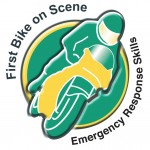 To say I was impressed with the program would be an understatement and after walking away I could not help thinking that it possibly should be a mandatory element of the driving test for ALL road users. At the very least it should be officially supported by the government in some way either by part funding or exclusion from, or lowered VAT – along with all rider safety equipment for that matter, but that’s another argument. Of course it would make sense to many of us, but it’s also wishful thinking and not likely to happen any time in the near future.
To say I was impressed with the program would be an understatement and after walking away I could not help thinking that it possibly should be a mandatory element of the driving test for ALL road users. At the very least it should be officially supported by the government in some way either by part funding or exclusion from, or lowered VAT – along with all rider safety equipment for that matter, but that’s another argument. Of course it would make sense to many of us, but it’s also wishful thinking and not likely to happen any time in the near future.
A likely argument from any politician on this issue would be “as a socially responsible citizen of any country it is up to you to inform, or train yourself to be able to help a fellow citizen in need of assistance by action or deed”. This is of course a fundamental building block of any civilised society along with an agreed set of laws and regulations to govern us by.
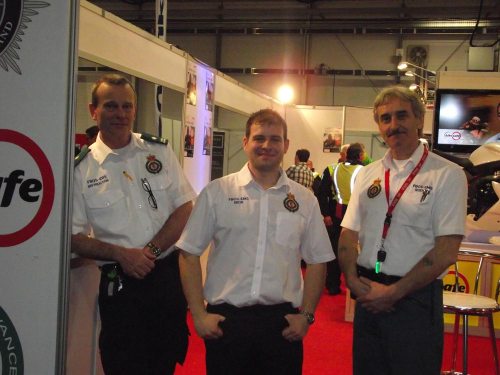
Nick, Ricky and Rodge at the Belfast Bike Show. A joint venture with the PSNI BikeSafe Team and Institute of Advanced Motorists.
But to swiftly get to my point without boring your tits off, this is why all of us in the biking community should at least consider financing ourselves to complete such a course. After talking to Nick and Rodge I quickly realised that while I have attended a number of first aid courses for workplace health and safety, and other courses in France with the French fire brigade and within a mountain rescue course I’d have absolutely no idea what to do if I came across a road accident involving a fellow biker due to it’s specific nature.
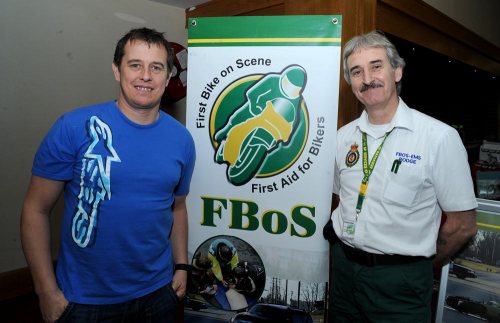
Rodge had the pleasure of meeting TT Legend John McGuinness!
The First Bike on Scene Emergency Response Skills Training
While most of us know to never remove an injured riders helmet as it can easily make matters far worse for a spinal injury, it may also be necessary to do so to save the riders life if he or she has stopped breathing for example. Knowing how to do this while reducing the risk to of possible further spinal injury is a very specific skill, and amongst others, these are two key features of the First Bike on Scene Emergency Response Skills training.
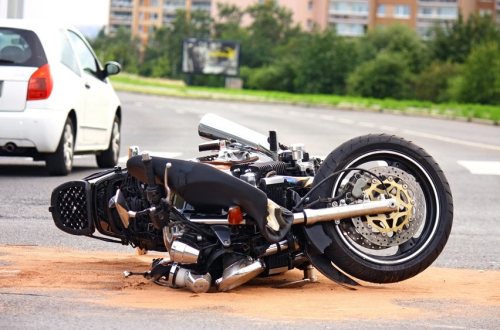
I know, it’s not something any of us want to see, but it can happen to the best of us!
This is certificate based training whereby, upon successful completion you will be entitled to a certificate from the Royal College of Surgeons in Edinburgh. Whether you live and complete the course in the UK or the Republic of Ireland this certificate will not qualify you to work as a brain surgeon or any form of medical professional. However it will look damn good on your CV and may well help you gain the coveted position as a marshal for the Isle of Man TT or any fixtures in Ireland or the UK which guarantees you a front row view, loads of free beer and the potential favorable attentions of revved up female race fans if you play your cards right.
Emergency Response Skills (ERS) Course
I’ve since been in contact with Nick of FBoS who has kindly sent us some excellent advice on dealing with a crash scene, this “might” help get you by at a pinch but does not compare to proper training. There are some very good tips here, so grab yourselves a cuppa and have a good read…
Provided by: Nick at FBoS
Contact email: nick (at) bikerstraining (dot) com
First Bike on Scene: Arriving first on the Scene of an Accident.
What should you do?
- The first priority in any emergency situation is to protect yourself! – Do not put yourself at risk.
- Check for oncoming traffic and consider the speed they might approach at. Do not go by the posted road speed limit; this is often disregarded
- AS A GUIDE – IF THE POSTED SPEED IS 100KPH MULTIPLY BY 3 for the required safe distance to attend a scene = 300 meters.
- An approximate safe distance from the scene may also be judged by making a fist at full arms length, extend your thumb (as for thumbs up sign).
- If the crashed car is obscured by the thumb the distance may be safe.
- A car travelling at 100kph may take over 120 meters to come to a halt!
- Put on a high visibility jacket if you do not routinely wear one when riding.
- Park your bike at the side of the road with hazard lights going if fitted.
- Observe the accident scene from a safe distance. How many vehicles are involved?
- Flag down approaching vehicles without putting yourself at risk, and ask these drivers to take over the task of stopping oncoming traffic.
- Advise these drivers to use ‘viz jackets’ and to keep safe.
- If it is safe to approach the crash scene listen out for running engines – switch of ignitions and remove keys.
- Do not attempt to remove people from the car or move the bike rider!
- Under no circumstances attempt to remove the biker’s helmet – this requires special training – see www.bikerstraining.com
- Ask all occupants to remain still and in the vehicle.
- Note how many are talking/ calling out in pain – these are conscious.
- Note how many are quiet – these may be unconscious.
- Ask the bike rider to remain still.
- Contact emergency services, remain calm. Answer the operator’s questions clearly and remain “on-line” until the operator tells you to hang up.
- As a final “good habit” be always aware of the route especially if the area is not so well known to you. Note obvious landmarks – church, pub, petrol – service station etc. Good to quote to emergency services to help them locate you swiftly.
…and some more basic advice from First Bike on Scene…
What Should You Do Before Setting Out
- Every motorist should be in the routine of checking their vehicle prior to setting out. This may be even more important for the biker.
- The obvious “wet” items such as petrol and oil are a given, but consider also chain lube and break fluid level.
- Have the tyre pressures been checked recently? Is there any wear and tear?
- Check all lights – keep them big and bright.
- Now the gear – never go cheap on the helmet; check the visor for scratches and grime.
- Jacket and trousers or “all in one” – never ride out without. Make sure every garment has at the very least a good level of abrasion resistance and is in fit condition to withstand a fall. The guy in jeans does not look cool – he looks a fool. That might sound like something your old man might say, but even minor road rash can leave horrific scars. More severe road rash can take up to a year for recovery and cause very serious secondary problems from repeated infections.
- Whether you put a “hi Viz” jacket on top is an individual choice (at the present) and some do argue that reflective gear does not enhance visibility. Our view, for what it’s worth, is that high visibility gear does not make you less visible.
- Get the best gloves you can afford and keep them in good order. To ride in less than the best motorcycling gloves is…..well try this – at the modest speed of 65kph a fall from a ‘bike without decent gloves is like trying to stop a grinding wheel at full tilt with bare fingers!
- The same applies to the boots; don’t go cheap, keep them in top condition and they will last a good few years.
- Are you riding alone or with others? If you are with a group each rider can look out for the others. Alone you have to look out for yourself. At the least ensure that others know your intended route and destination arrival time.
- You might consider bringing a First Aid Kit along; even if you don’t know how to use it, someone else might.
- Include a high visibility jacket even if you do not routinely wear one. At the scene of an accident this is essential wear.
- Finally, don’t forget your mobile phone. If things go wrong you will need to call for help.
The Course Details: Cost, Venue and Schedule
Nick and Rodge from FBoS are running this excellent Emergency Response Skills (ERS) course all across the UK, Northern Ireland and now the Republic of Ireland. The total cost for the course is €70 / £ 69 per person plus €10 / £10 for the certification and the course lasts a full day.
The Course Venues & Schedule »
For more information and contact details visit FBoS official website »
B.I.K.E.R.S Training Ireland on Facebook »
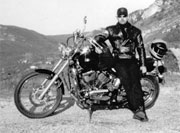







In the Uk alot of the fire & rescue services are doing the Biker Down training course, a very good course started by Jim at Ashford Kent fire station, well worth doing as you never know.
Thanks for the tip, I didn’t know the fire & rescue services were doing a Biker Down training course too. Like you said you never know and what you learn can be of great use even for accidents around the home like a bad fall down a stairs.
It’s also a bit a fun and a chance to meet other like minded lads.
Den